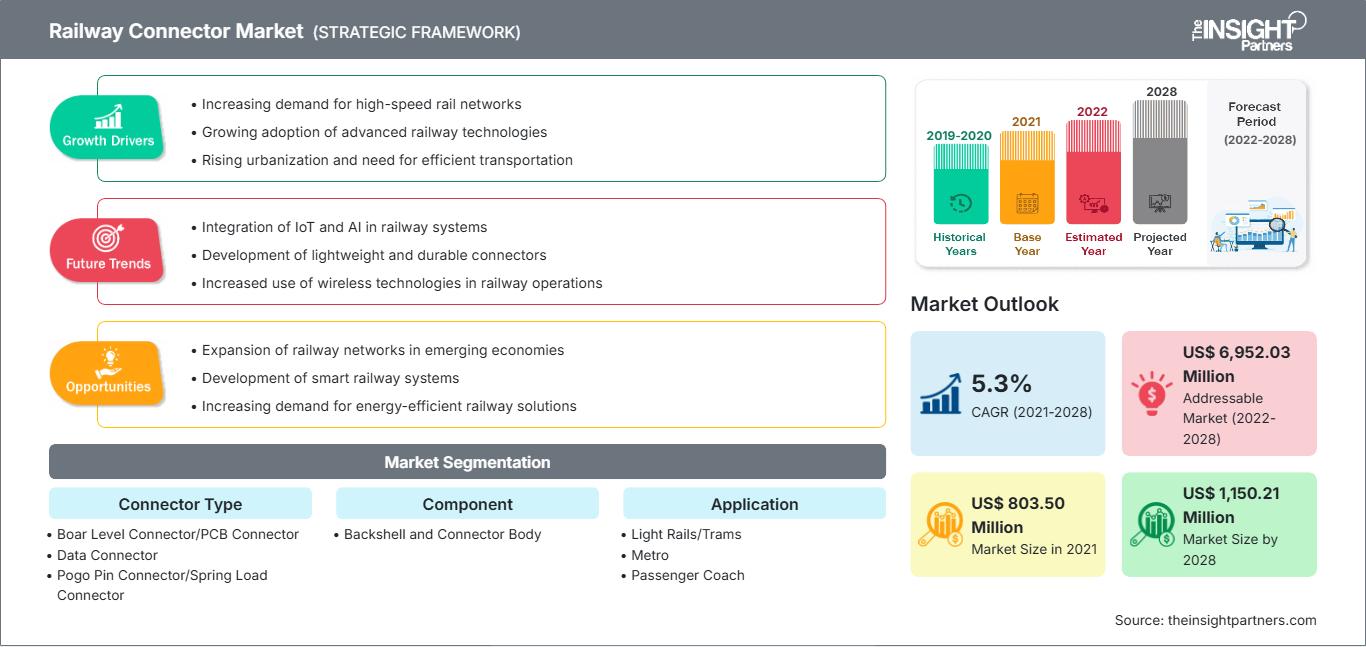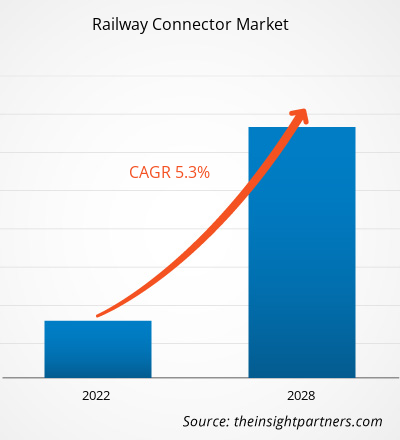Se prevé que el mercado de conectores ferroviarios crezca de 803,50 millones de dólares estadounidenses en 2021 a 1.150,21 millones de dólares estadounidenses en 2028; se estima que crecerá a una tasa de crecimiento anual compuesta (TCAC) del 5,3% entre 2021 y 2028.
El crecimiento demográfico, los cambios en el estilo de vida y la rápida urbanización exigen un sistema de comunicación ferroviaria interconectado, impulsando así el crecimiento del mercado. Además, el aumento de las velocidades de transmisión de datos y la creciente miniaturización de los dispositivos electrónicos fomentan el desarrollo de soluciones de comunicación compactas, robustas y de alta velocidad. La aparición de redes de transmisión digital en las vías férreas plantea a los fabricantes el reto de desarrollar conceptos de sistema e interfaces de equipos adecuados para la comunicación de datos complejos. Muchos vehículos europeos están equipados con tecnologías avanzadas, como la transmisión inalámbrica de datos, lo que se prevé que impulse la demanda de conectores ferroviarios para la comunicación de datos complejos en Europa durante el período de previsión.
Obtendrá personalización gratuita de cualquier informe, incluyendo partes de este informe, análisis a nivel de país y paquetes de datos de Excel. Además, podrá aprovechar excelentes ofertas y descuentos para empresas emergentes y universidades.
Mercado de conectores ferroviarios: Perspectivas estratégicas

-
Obtenga las principales tendencias clave del mercado que se describen en este informe.Esta muestra GRATUITA incluirá análisis de datos, que abarcarán desde tendencias de mercado hasta estimaciones y pronósticos.
Impacto de la pandemia de COVID-19 en el mercado de conectores ferroviarios
En 2020, la pandemia de COVID-19 tuvo un impacto negativo a gran escala en las economías globales. La pandemia generó numerosos desafíos en diversos mercados, como el de conectores ferroviarios. La oferta y la demanda se redujeron considerablemente debido a la baja producción. Además, la industria ferroviaria se vio afectada negativamente por los confinamientos. Las restricciones en la cadena de suministro paralizaron la fabricación de conectores ferroviarios en todo el mundo. Sin embargo, las perspectivas para los proyectos ferroviarios se mantuvieron positivas en 2021. Por lo tanto, la demanda de conectores ferroviarios aumentó a partir de ese año.
Perspectivas de mercado: Mercado de conectores ferroviarios
La aparición de trenes sin conductor impulsará el mercado de conectores ferroviarios durante el período de previsión.
Increasing electrification across the global transportation industry irrespective of the mode of transport has led to the development of automated transport methods. Trains are the frontrunners of transport automation after road transport, as autonomous driving is making its entry into the railway sector. In Europe, automatic train operation (ATO) is becoming the latest trend that modernizes the region's railway sector. In October 2019, six German companies, led by Siemens Mobility, started a joint project named “AStriD.” The growing urban and local transport propels the need to integrate advanced and automated systems in rail to optimize train operations. Therefore, increasing demand of connectors in autonomous trains offers advantages to the players operating in the railway connector market.
Connector Type-Based Insights
Based on connector type, the railway connector market is segmented into broad level connector/PCB connector, data connector, pogo pin connectors/spring load connector, power connector, and others. The broad-level connector/PCB connector segment held the largest market share in 2021.
Players operating in the railway connector market are mainly focused on developing advanced and efficient products.
- In January 2021, Fischer Connectors Group started the construction of a new manufacturing facility in Portugal.
- In June 2021, TT Electronics' AB Connectors became gold members of rail forum Midlands.
Railway Connectors
Railway Connector Market Regional Insights
The regional trends and factors influencing the Railway Connector Market throughout the forecast period have been thoroughly explained by the analysts at The Insight Partners. This section also discusses Railway Connector Market segments and geography across North America, Europe, Asia Pacific, Middle East and Africa, and South and Central America.
Railway Connector Market Report Scope
| Report Attribute | Details |
|---|---|
| Market size in 2021 | US$ 803.50 Million |
| Market Size by 2028 | US$ 1,150.21 Million |
| Global CAGR (2021 - 2028) | 5.3% |
| Historical Data | 2019-2020 |
| Forecast period | 2022-2028 |
| Segments Covered |
By Connector Type
|
| Regions and Countries Covered |
North America
|
| Market leaders and key company profiles |
|
Railway Connector Market Players Density: Understanding Its Impact on Business Dynamics
El mercado de conectores ferroviarios está creciendo rápidamente, impulsado por la creciente demanda de los usuarios finales debido a factores como la evolución de las preferencias de los consumidores, los avances tecnológicos y una mayor conciencia de las ventajas del producto. A medida que aumenta la demanda, las empresas amplían su oferta, innovan para satisfacer las necesidades de los consumidores y aprovechan las nuevas tendencias, lo que impulsa aún más el crecimiento del mercado.

- Obtenga una visión general de los principales actores del mercado de conectores ferroviarios.
El mercado de conectores ferroviarios se segmenta según el tipo de conector, el componente, la aplicación y la geografía. Según el tipo de conector, el mercado se divide en conectores de placa de circuito impreso (PCB), conectores de datos, conectores de pines de resorte, conectores de alimentación y otros. En 2021, el segmento de conectores de placa de circuito impreso (PCB) lideró el mercado y representó la mayor cuota de mercado. Según el componente, el mercado se divide en carcasa trasera y cuerpo del conector. En 2021, el segmento de cuerpos de conector lideró el mercado y representó una mayor cuota de mercado. Según la aplicación, el mercado de conectores ferroviarios se segmenta en tren ligero/tranvías, metro, vagones de pasajeros y otros. En 2021, el segmento "otros" lideró el mercado y representó la mayor cuota de mercado. Geográficamente, el mercado se segmenta en Norteamérica, Europa, Asia Pacífico (APAC), Oriente Medio y África (MEA) y Sudamérica (SAM). En 2021, APAC representó una parte significativa del mercado global de conectores ferroviarios.
Amphenol Corporation, Kyocera-AVX, Fischer Connectors SA, Harting Technology Group, Molex, LLC (Koch Industries, Inc.), Schaltbau GmbH, Allied Electronics Corporation, Smiths Interconnect, TE Connectivity Corporation y TT Electronics figuran entre los principales actores analizados en este estudio de mercado. Además, se estudiaron y analizaron otros actores clave del mercado para obtener una visión integral del mercado de conectores ferroviarios y su ecosistema.
- Análisis histórico (2 años), año base, pronóstico (7 años) con CAGR
- Análisis PEST y FODA
- Tamaño del mercado, valor/volumen: global, regional y nacional
- Industria y panorama competitivo
- Conjunto de datos de Excel
Informes recientes
Informes relacionados
Testimonios
Razón para comprar
- Toma de decisiones informada
- Comprensión de la dinámica del mercado
- Análisis competitivo
- Información sobre clientes
- Pronósticos del mercado
- Mitigación de riesgos
- Planificación estratégica
- Justificación de la inversión
- Identificación de mercados emergentes
- Mejora de las estrategias de marketing
- Impulso de la eficiencia operativa
- Alineación con las tendencias regulatorias






















 Obtenga una muestra gratuita para - Mercado de conectores ferroviarios
Obtenga una muestra gratuita para - Mercado de conectores ferroviarios